Investigations of Faraday Rotation Maps of Extended Radio Sources ...
Investigations of Faraday Rotation Maps of Extended Radio Sources ...
Investigations of Faraday Rotation Maps of Extended Radio Sources ...
Create successful ePaper yourself
Turn your PDF publications into a flip-book with our unique Google optimized e-Paper software.
102 CHAPTER 5. A BAYESIAN VIEW ON FARADAY ROTATION MAPS<br />
where 1 {condition} is equal to unity if the condition is true and zero if not and Ω defines<br />
the region for which RM’s were actually measured. The electron density distribution<br />
n e (⃗x) is chosen with respect to a reference point ⃗x ref (usually the cluster centre) such<br />
that n e0 = n e (⃗x ref ), e.g. the central density, and B 0 = 〈 B ⃗ 2 (⃗x ref )〉 1/2 . The dimensionless<br />
average magnetic field pr<strong>of</strong>ile g(⃗x) = 〈 B ⃗ 2 (⃗x)〉 1/2 /B 0 is assumed to scale<br />
with the density pr<strong>of</strong>ile such that g(⃗x) = (n e (⃗x)/n e0 ) α B<br />
.<br />
Setting ⃗x ′ = ⃗x +⃗r and assuming that the correlation length <strong>of</strong> the magnetic field is<br />
much smaller than characteristic changes in the electron density distribution, one can<br />
separate the two integrals in Eq. (5.5). Furthermore, one can introduce the magnetic<br />
field autocorrelation tensor M ij = 〈B i (⃗x) · B j (⃗x + ⃗r)〉 (see e.g. Subramanian 1999;<br />
Enßlin & Vogt 2003). Taking this into account, the RM autocorrelation function can<br />
be described by<br />
C RM (⃗x ⊥ , ⃗x ⊥ + ⃗r ⊥ ) = ã 0<br />
2<br />
∫ ∞<br />
z s<br />
dz f(⃗x)f(⃗x + ⃗r)<br />
∫ ∞<br />
(z ′ s −z)→−∞<br />
dr z M zz (⃗r) (5.7)<br />
Here, the approximation (z s ′ − z) → −∞ is valid for <strong>Faraday</strong> screens which are much<br />
thicker than the magnetic autocorrelation length. This will turn out to be the case in<br />
the application at hand.<br />
The Fourier transformed zz-component <strong>of</strong> the autocorrelation tensor M zz ( ⃗ k) can<br />
be expressed by the Fourier transformed scalar magnetic autocorrelation function w(k)<br />
= ∑ i M ii(k) and a k dependent term (see Eq. (3.25)) leading to<br />
M zz (⃗r) = 1 ∫ ∞<br />
2π 3 d 3 k w(k)<br />
( )<br />
1 − k2 z<br />
2 k 2 e −i⃗ k⃗r<br />
(5.8)<br />
−∞<br />
Furthermore, the one dimensional magnetic energy power spectrum ε B (k) can be expressed<br />
in terms <strong>of</strong> the magnetic autocorrelation function w(k) such that<br />
ε B (k) dk = k2 w(k)<br />
dk. (5.9)<br />
2 (2π) 3<br />
As stated in Chapter 3, the k z = 0 - plane <strong>of</strong> M zz ( ⃗ k) is all that is required to<br />
reconstruct the magnetic autocorrelation function w(k). Thus, inserting Eq. (5.8) into<br />
Eq. (5.7) and using Eq. (5.9) leads to<br />
C RM (⃗x ⊥ , ⃗x ⊥ + ⃗r ⊥ ) = 4π 2 ã 0<br />
2<br />
∫ ∞<br />
−∞<br />
∫ ∞<br />
z s<br />
dz f(⃗x)f(⃗x + ⃗r) ×<br />
dk ε B (k) J 0(kr ⊥ )<br />
, (5.10)<br />
k<br />
where J 0 (kr ⊥ ) is the 0th Bessel function. This equation gives an expression for the<br />
RM-autocorrelation function in terms <strong>of</strong> the magnetic power spectra <strong>of</strong> the <strong>Faraday</strong><br />
producing medium.<br />
Since the magnetic power spectrum is the interesting function, one can parametrise<br />
ε B (k) = ∑ p ε B i<br />
1 {k ∈ [kp,k p+1 ]}, where ε Bi is constant in the interval [k p , k p+1 ], leading<br />
to<br />
∫ ∞<br />
C RM (ε Bp ) = 4π 2 2 ã 0 dz f(⃗x)f(⃗x + ⃗r) ∑ ∫ kp+1<br />
ε Bp dk J 0(kr ⊥ )<br />
, (5.11)<br />
z s p k p<br />
k<br />
where the ε Bp are to be understood as the model parameter a p for which the likelihood<br />
function L ⃗∆) (a p ) has to be maximised given the <strong>Faraday</strong> data ∆.
















